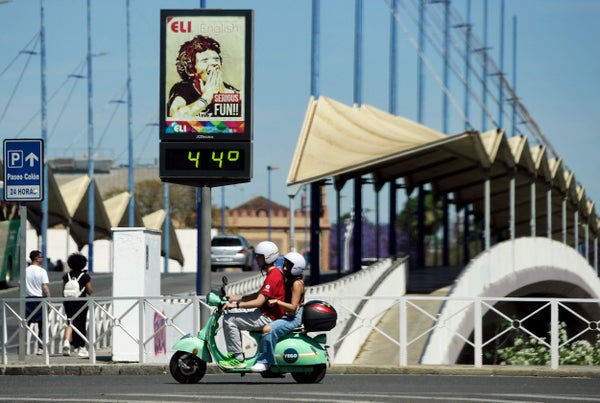CLIMATEWIRE | The city of Seville, Spain, has declared its second-ever named heat wave as much of the country swelters under blistering conditions. “Yago” earned the city’s most severe heat wave ranking, a Category 3, as temperatures soared above 111 degrees Fahrenheit on Monday.
Seville is among the first cities in the world to implement a system for naming and ranking heat waves, similar to the way scientists designate hurricanes. It officially launched a pilot program in June 2022, and heat wave Zoe became its first named event a month later.
The system uses a three-tiered ranking system, with Category 3 as the most severe. Each category has specific criteria, including both daytime and nighttime temperatures, humidity and expected impacts on human health.
On supporting science journalism
If you're enjoying this article, consider supporting our award-winning journalism by subscribing. By purchasing a subscription you are helping to ensure the future of impactful stories about the discoveries and ideas shaping our world today.
Each tier also triggers a set of emergency response services, like issuing weather alerts and public information campaigns, opening cooling centers and dispatching teams to check on vulnerable populations.
Only the most severe heat waves — those reaching at least a high-end Category 2 or low-end Category 3 over three days — receive a name.
The initiative is a collaboration between the city of Seville and the Atlantic Council’s Adrienne Arsht-Rockefeller Foundation Resilience Center (Arsht-Rock), including other partners such as the Spanish Office for Climate Change and several Spanish universities and research institutes. The idea is to reduce heat-related illness and death by making the public more aware of the dangers.
The new system launched last year as Spain roasted under record-breaking heat. Temperature records toppled across the country — Madrid matched its all-time hottest temperature record, at 105.3 degrees, while numerous other cities around the country broke daily and monthly records.
The first two weeks of June 2022 were the country’s hottest on record, according to the Spanish national meteorological service. And Europe as a whole saw its second-hottest June on record in 2022, according to the European Union’s Copernicus Climate Change Service.
Yago is only the second named heat wave to strike Seville, but other dangerous, categorized heat events have struck the city since the program was launched. It’s not the first heat wave to hit Spain in 2023. Heat gripped the country in April, sending temperatures soaring above 100 degrees in some places.
This spring was the country’s hottest on record and its second-driest, according to the Spanish national meteorological service.
For now, the new naming and ranking system applies only to Seville. The program’s organizers have made minor tweaks over the last year, according to Kurt Shickman, director of Arsht-Rock’s heat initiative.
So far, he said, “it seems to be working as we intended from last year — and has actually started to change some behavior.”
Surveys in Seville and surrounding areas after Zoe last year indicated that the program made people more likely to take protective measures against the heat, he said, and were more likely to check on their neighbors. They also reported a higher level of trust in their government’s ability to protect them from extreme heat.
“It’s early days — I don’t want to overstate it,” Shickman said. “But I think what we’re seeing is, if messaged properly and well, it does seem to contribute to the types of preventative measures we want people to take to stay safe.”
Seville isn’t the only city to implement such a system. Arsht-Rock has launched similar programs in cities across Greece in the last year. The Greek system involves only ranking heat events, without naming them, but uses a similar algorithm to evaluate and categorize them.
Meanwhile, a handful of U.S. cities have announced similar pilot programs, including Los Angeles, Miami, Milwaukee and Kansas City, Mo. And last September, California adopted a law establishing a heat wave ranking system that must go into effect by Jan. 1, 2025.
These kinds of ranking systems can be established with fairly limited resources, Shickman said, making them particularly useful in low- and middle-income nations.
“I think this heat health categorization is really critical,” he said. “We’re seeing that this can really help communities get themselves prepared.”
Reprinted from E&E News with permission from POLITICO, LLC. Copyright 2023. E&E News provides essential news for energy and environment professionals.
